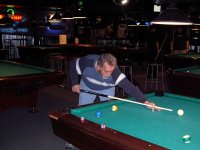Knuckles straight downward at the floor, wrist is straight, no flex or bending-completing the stroke,
back of the palm facing the wall and minimal shoulder movement at all times so your arm just moves
forward and collapses. In other words, your forearm and lower biceps touch. Don’t death squeeze the
butt and just grip the cue with fingers spread as if you were handshaking with the cue butt. The final
and may be the most critical is following thru on the stroke…..don’t quit on it, don’t jab it, don’t draw
back slowly & fast accelerate your forward stroke. Try to get a balance and rhythm to your stroke that
has a smooth glide like action through your bridge fingers and let your cue tip extend beyond the cue
ball’s original position. Now I know you have to stroke the cue ball differently for various shots not only
to pocket the OB but attain the desired shape. But your fundamental stroke has to be mechanically and
rhythmically sound or your progress will ceiling out. You’ll miss shots because of your stroke mechanics.
Sure, everyone makes an occasional mechanical mistake but if the mistakes keep reoccurring, is it really
a mistake? Know what it is called? Yup, it’s the dreaded term none of us ever want to admit to….a flaw.
So fix it and work on your stroke…….consistency is the goal…..keep practice strokes to a minimum before
you stroke the cue ball (2-5 strokes is more than ample)……maintain a suitable bridge distance…..make sure
your mind is blank…..no thoughts at all……after you stroke the cue ball, stay down in stroke position with your
hand still on the cloth and observe the cue ball path, speed and English you “intended” rather than “unintended”
because the cue ball never lies. It tells you exactly what you did right or wrong. I don’t get out of my shooting
stance until after the cue ball stops rolling. I often have to lift my bridge hand to let the cue ball pass. I observe
the cue ball for its velocity as it comes off a rail. I evaluate the shot results which helps me correct any flaws that
we all have manifest it seems at the worst moments. Remember the cue ball never lies to you so learn to read it.
Think of it this way…….your cue can be played like a violin or played like a fiddle. Both instruments look alike and
have four strings. People often think of them as being the same instrument but admittedly, the acoustical sounds
produced are strikingly different. Well, your cue has to be both and it’s your stroke that decides which one on every
shot. Yes, your stroke & bridge will change during a game but if you do not possess a sound one, your game suffers.
